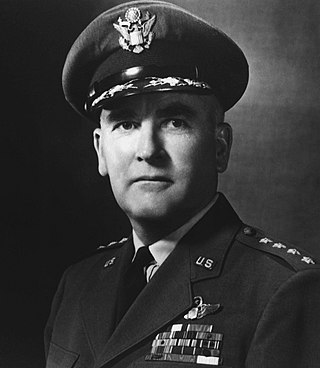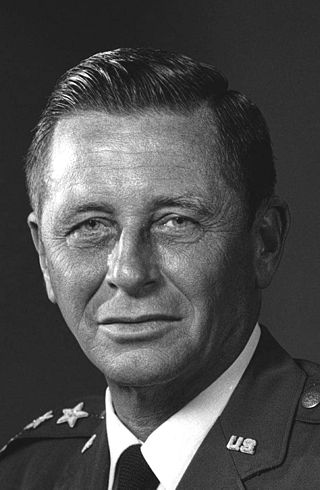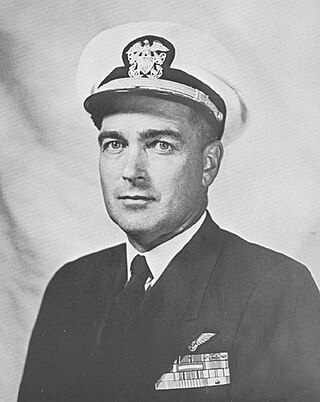
The National Geospatial-Intelligence Agency (NGA) is a combat support agency within the United States Department of Defense whose primary mission is collecting, analyzing, and distributing geospatial intelligence (GEOINT) in support of national security. Initially known as the National Imagery and Mapping Agency (NIMA) from 1996 to 2003, it is a member of the United States Intelligence Community.

Roscoe Henry Hillenkoetter was the third director of the post–World War II United States Central Intelligence Group (CIG), the third Director of Central Intelligence (DCI), and the first director of the Central Intelligence Agency created by the National Security Act of 1947. He served as DCI and director of the CIG and the CIA from May 1, 1947, to October 7, 1950, and, after his retirement from the United States Navy, was a member of the board of governors of National Investigations Committee On Aerial Phenomena (NICAP) from 1957 to 1962.

Kenneth A. Minihan is a former United States Air Force lieutenant general who served as the director of the National Security Agency and the Defense Intelligence Agency, retiring on May 1, 1999.

William Hedgcock Webster is an American attorney and jurist who most recently served as chair of the Homeland Security Advisory Council from 2005 until 2020. He was a United States district judge of the United States District Court for the Eastern District of Missouri and a United States circuit judge of the United States Court of Appeals for the Eighth Circuit before becoming director of the Federal Bureau of Investigation (FBI) from 1978 to 1987 and director of Central Intelligence (CIA) from 1987 to 1991. He is the only person to have held both positions.

The National Intelligence Distinguished Service Medal (NIDSM) is a decoration awarded for service to the United States Intelligence Community. The decoration is awarded to any member or contributor to the National Intelligence Community, either civilian or military, who distinguishes themselves by meritorious actions to the betterment of national security in the United States of America, through sustained and selfless service of the highest order.

Charles Pearre Cabell was a United States Air Force general and Deputy Director of the Central Intelligence Agency (1953–1962).

Lieutenant General Samuel Vaughan Wilson, aka "General Sam", completed his active military career in the fall of 1977, having divided his service almost equally between special operations and intelligence assignments.

Dino Antonio Brugioni was a former senior official at the CIA's National Photographic Interpretation Center (NPIC). He was an imagery analyst and also served as NPIC's Chief of Information. During his 35-year career, Brugioni helped establish imagery intelligence (IMINT) as a national asset to solve intelligence problems. Even after retirement, Brugioni was considered to be the world's foremost imagery intelligence analyst.

Arthur Charles Lundahl KBE was a forerunner of American Cold War imagery intelligence (IMINT) and aerial reconnaissance known for his discovery of Soviet missile installations in Cuba in 1962 which led to the Cuban Missile Crisis. He was responsible for establishing the Central Intelligence Agency's National Photographic Interpretation Center, a forerunner of the National Geospatial-Intelligence Agency, and led the photointerpretation section of the U-2 reconnaissance program. Analyzing reconnaissance films, he briefed presidents Eisenhower and Kennedy as well as the nation's top military and diplomatic officials. Lundahl provided critical intelligence on the arms race and many other international crises, including the Suez Crisis; Quemoy and Matsu, islands controlled by Taiwan; Tibet; Lebanon, and Laos.

General Robert James Dixon was a four-star general and Command Pilot in the United States Air Force (USAF) who served as Commander, Tactical Air Command (COMTAC) from 1973 to 1978. He also served simultaneously as commander in chief of U.S. Air Forces for both the U.S. Atlantic Command and U.S. Readiness Command.
The Intelligence Medal of Merit is awarded by the Central Intelligence Agency for performance of especially meritorious service or for achievement conspicuously above normal duties.

William Lloyd Nicholson III was an American Air Force major general. As his last assignment, he was director of the Defense Mapping Agency from July 1979 – June 1981.

Frederick Wistar Morris Janney was a career Central Intelligence Agency officer who was recruited by Allen Dulles in 1949. He held a number of positions during his thirty-year career and was awarded the Agency's highest honor, the Distinguished Intelligence Medal, four days after his death.

Robert M. Huffstutler was director of National Photographic Interpretation Center from February 1984 to January 1988.

Nancy E. Bone is an American former intelligence officer who served as Director of National Photographic Interpretation Center between October 1993 and September 1996.

Rutledge Parker "Hap" Hazzard was director of Science and Technology division of Central Intelligence Agency (CIA) from 1973 to 1978. He became director of the National Photographic Interpretation Center (NPIC) in 1978. After serving six years as director of NPIC from June 1978 to February 1984, Hazzard returned to the CIA's National Intelligence Office. He retired from public service in 1985.

Frank J. Ruocco was fifth director of National Photographic Interpretation Center (NPIC) from February 1988 to February 1991.

Leo A. Hazlewood was Director of National Photographic Interpretation Center from February 1991 – September 1993), and Deputy Director of National Imagery and Mapping Agency from July 1997 – January 2000. He also served as Deputy Director of Operations at National Imagery and Mapping Agency.

Rear Admiral Joseph John "Jack" Dantone Jr. of U.S. Navy, was last director of Defense Mapping Agency (DMA) from May 1996 to September 1996. He was also the Acting Director of National Imagery and Mapping Agency (NIMA) from October 1996 to March 1998. He played a major role in transition of DMA into NIMA.

Damon Warren "Hutch" Cooper was a United States Navy Vice admiral who served in conflicts from the 1940s through the 1970s, including as the Commander, Task Force 77 during the late stages of the Vietnam War.



















